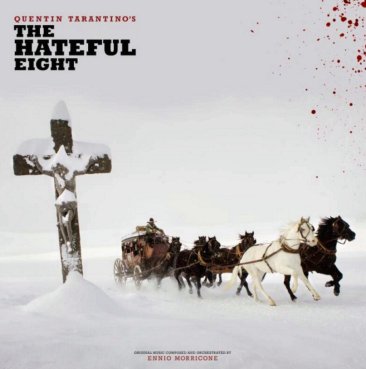Ennio Morricone’s Score for The Hateful Eight | A Review
Ennio Morricone provides a suitably menacing soundtrack to Tarantino’s intimate return; The Hateful Eight. Set in the snowcapped mountains of Wyoming, the film recounts the tale of a bounty hunter and his prisoner forced to take shelter from an impending blizzard in a cabin full of degenerate gunslingers. In a similar style to Reservoir Dogs (1992), Tarantino sets the majority of this western in a single location, Minnie’s Haberdashery, an isolated pit-stop for travellers on their way to Red Rock. The result is a tense and, at times, claustrophobic atmosphere, unnerving for both the characters and the audience alike.

Following much consideration, Morricone (87) agreed to compose an entirely original soundtrack for the film, marking his first western score in 35 years, his most recent being Michele Lupo’s Buddy Goes West (1981). His employment came as a shock to Tarantino fans as it marked a departure from what had become an integral part of Quentin’s approach to film-making; the compilation score. For over two decades Tarantino had decorated his films with popular music, building bridges between pre-existing lyrics and melodies with his fictional characters and storylines. However when Morricone (The Good, the Bad and the Ugly (1966) and Once Upon a Time in The West (1968)) offered his services, Tarantino simply couldn’t resist.
Perhaps one of the most striking features of The Hateful Eight’s soundtrack is its classical nature. Despite being composed for a violent western, Morricone’s score remains classical in both instrumentation and arrangement. In an interview with Vulture prior to the release of the film, Tarantino quipped that there was “no whistling in this score“. This was a reference to the country/folk-based soundtrack of his previous western Django Unchained (2012) which largely consisted of twanging guitars and other genre clichés. Instead The Hateful Eight sees Morricone boast his Italian roots as he embraces the nerve-jangling discord best associated with the Italian Giallo genre. This is simply an Italian thriller genre of films that deal with mystery, violence, crime fiction and supernatural horror. Morricone is using the music as a weapon to unnerve, isolate and horrify the audience.
This is best showcased in his use of classical instrumentation. Throughout the film the audience is subjected to long sustained notes in the brass section, creating an ominous atmosphere. Morricone decorates this tension with unsettling string-based motifs. His melodies are simple. His ideas are short, cold and uninviting. In addition the music acts as an aural accompaniment to the treacherous weather conditions of Wyoming. This is very similar to the desired effect in Joel and Ethan Coen’s Fargo (1996) in which Carter Burwell’s soundtrack casts the landscape as an integral part of the plot. As Tarantino’s opening sequence establishes the isolated setting of the Wyoming mountainside, Morricone’s L’ultima Diligenza di Red Rock (The Last Stage to Red Rock) marries this image in a suitably horrifying and unnerving fashion.
[youtube id=”HhsXy-f2Q0U” align=”center” autoplay=”no” maxwidth=”750"]
With over 50 minutes of original music featured in The Hateful Eight, Tarantino’s emphasis on aural accompaniment is clear to be seen. However if one piece were to rise above all others in capturing Morrcione’s desired effect, it would be the spine-tingling Narratore Letterario. This 2 minute instrumental best showcases the psychotic nature of the film’s characters while also capturing the rising tension and sense of foreboding within Minnie’s Haberdashery. Morricone’s score, much like The Hateful Eight, is not for the faint-hearted, rather we are treated to a soundtrack that does not crave our attention, but demands it.
Featured Image Source

